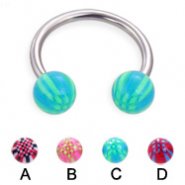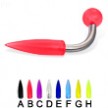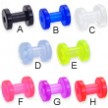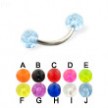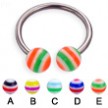Circular barbell with acrylic checkered balls, 14 ga
- Gauge (Thickness): 14 (1.6mm)
- Material: 316L surgical grade stainless steel
- Material: acrylic
- Type: circular barbell
Shown: 14mm circular barbell with 6mm balls.
| Click on the picture to see a big picture and description of the body jewelry you are interested in. | |||||||||
|---|---|---|---|---|---|---|---|---|---|
|
Acrylic spike and ball titanium curved...
$7.20
Acrylic spike and ball titanium curved barbell, 12 ga
Shown: 11mm curved barbell. |
6 gauge acrylic tunnel with threaded...
$4.49
6 gauge acrylic tunnel with threaded back
|
Glitter ball curved barbell, 14 ga
$2.99
Glitter ball curved barbell, 14 ga
Due to the non-transparent nature of the black balls you won't see as much glitter on them as with our other colors Shown: 12mm curved barbell with 6mm balls. |
Titanium horseshoe barbell with circle balls,...
$7.49
Titanium horseshoe barbell with circle balls, 14 ga
Shown: 13mm horseshoe barbell with 6mm balls. |
||||||
Niobium
An elemental metal, strong yet flexible; slightly heavier than 316L stainless. Niobium is non-reactive chemically; few people are sensitive to niobium. The wide array of colors achieved through anodizing (not dyeing), in which the jewelry is submerged in an electrolite solution. Anodizing forms an oxide layer on the jewelry. The color seen is light refracted through this layer; the thickness of the layer determines the particular color produced. The voltage applied during anodizing determines the thickness of the oxide layer and hence the resulting color. The anodized layer of oxide will eventually wear away; how long the process will take depends on how thick the oxide layer is and the amount of friction and wear on the jewelry. Some colors will start to fade within 6 months.
Matte black is achieved by heating the niobium until it is red-hot and cooling it. After blackening, the jewelry can be polished to a certain degree. Black niobium will not fade; rather, it will deepen and grow smoother with age and wear.
Niobium jewelry is available in matte (“satin”) or high-polish (“mirror”) finishes. Very rough-finished niobium should not be used for fresh/unhealed piecings, as the pores present in the matte finish can trap bacteria as well as retain polishing-compound residue which can be toxic. The rough finish will also have a tendency to “stick” to new piercings via dried discharge, which can cause the newly-formed tissue to rupture, extending healing time.
